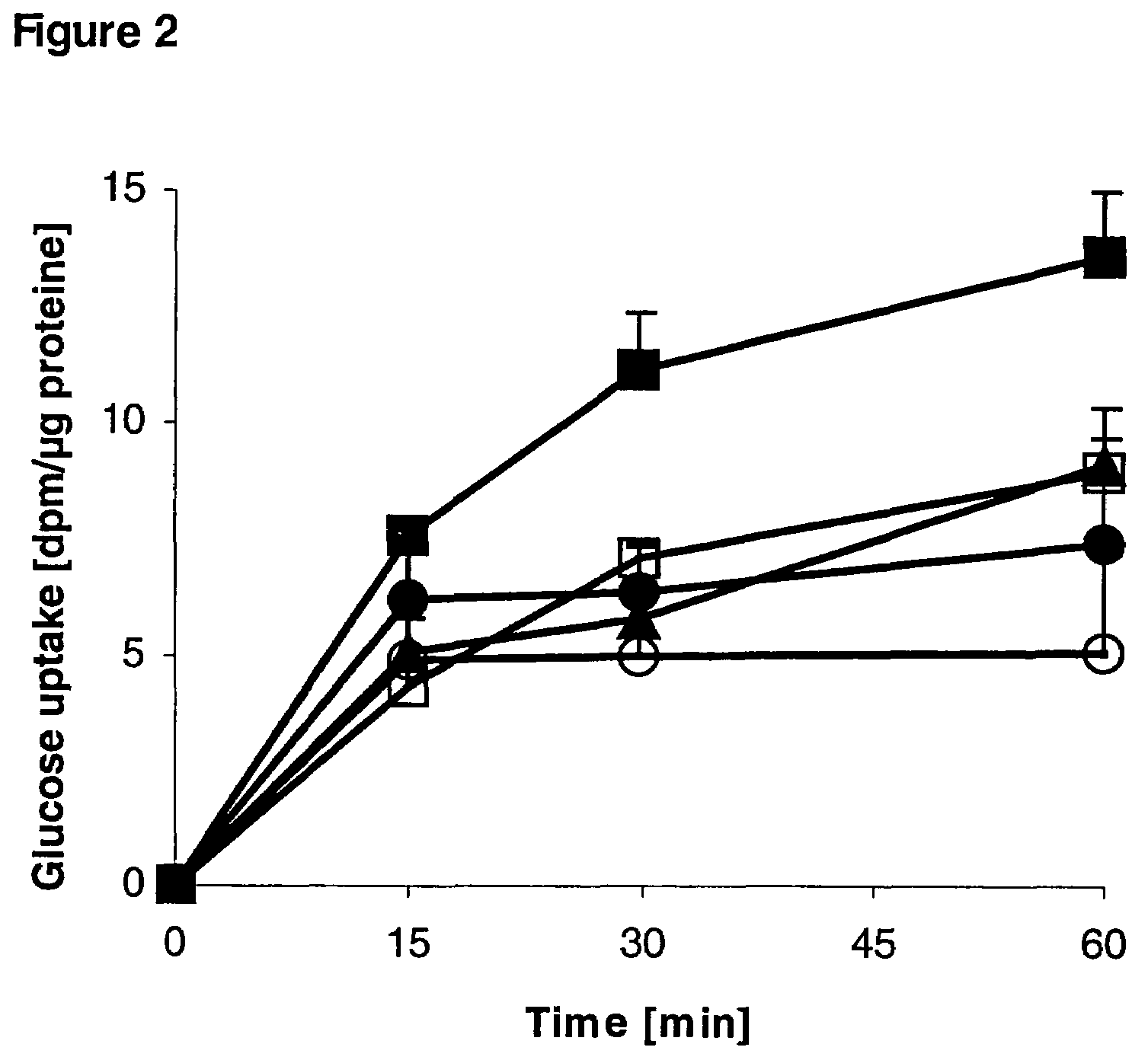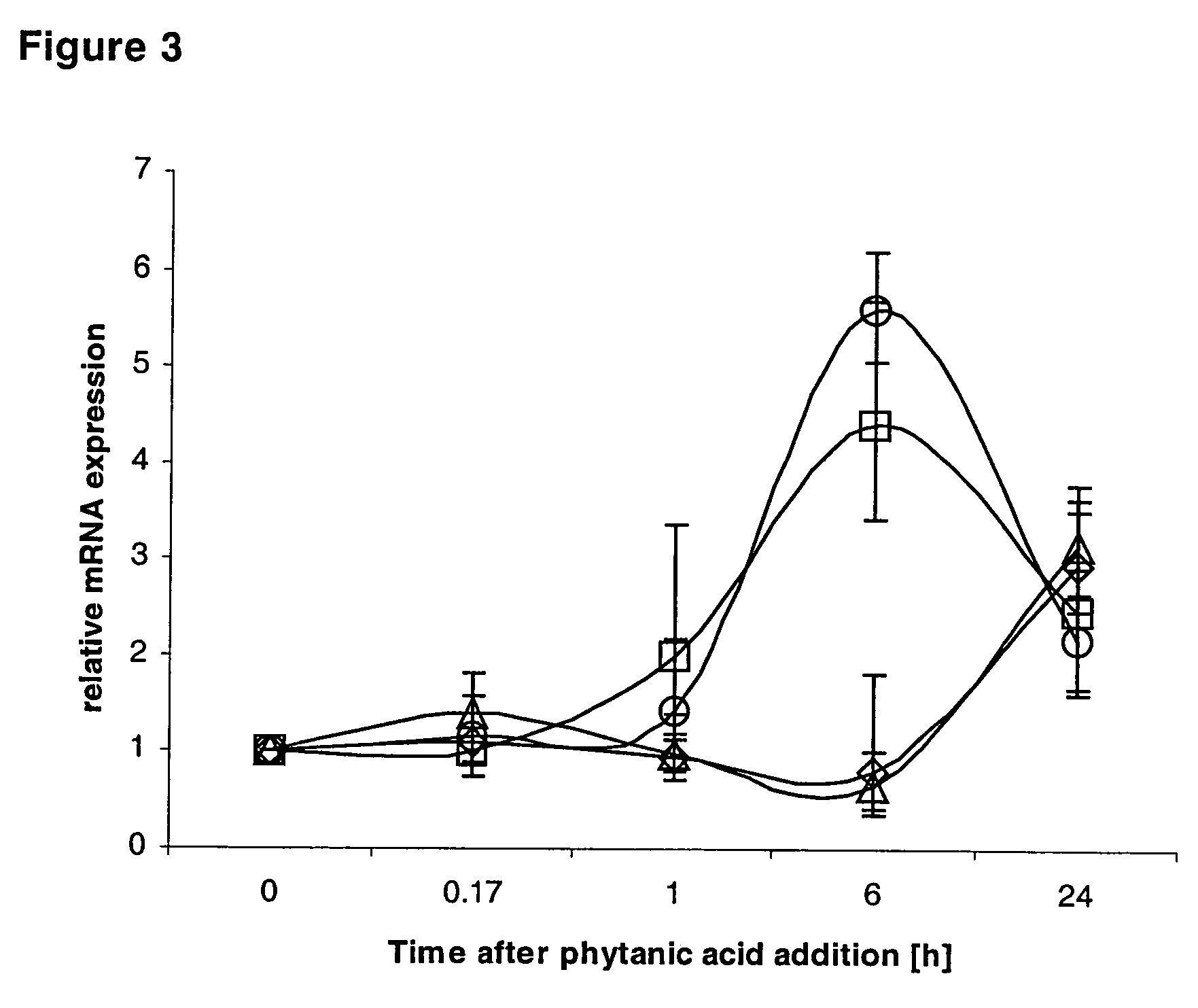Method of treating non-insulin dependent diabetes mellitus with phytanic acid derivatives
- Summary
- Abstract
- Description
- Claims
- Application Information
AI Technical Summary
Benefits of technology
Problems solved by technology
Method used
Image
Examples
example 1
Cell Viability
[0059]Viability of cells cultivated under the above conditions was determined by neutral red uptake assay (Maria C. Martinez-Diez, Maria A. Serrano, Maria J. Monte, Jose J. G. Marin, Comparison of the effects of bile acids on cell viability and DNA synthesis by rat hepatocytes in primary culture, Biochimica et Biophysica Acta 1500 (2000) 153–160). In brief, a final Neutral red concentration of 50 μg / ml in sterile PBS was used. This solution was prewarmed to 37° C. before its use. The cells were washed once with PBS to remove non-adherent and dead cells. This was replaced by Neutral red-containing medium. The cultures were incubated for 3 h at 37° C. in an atmosphere of 5% CO2, 95% air allowing the lysosomes and Golgi apparatus of viable cells to take up the dye. The cultures were then carefully washed with Neutral red-free PBS to eliminate remaining extracellular dye. The incorporated Neutral red was eluted from the hepatocytes with 50% ethanol supplemented with 1% ace...
example 2
2-deoxy-D-glucose Uptake
[0061]Cells cultured in 24-well plates were treated for 24 h with phytanic acid, palmitic acid, and DHA. Subsequently the medium was removed and cells were washed twice with pre-warmed phosphate buffered saline, pH 7.4 (PBS). 500 μl of pre-warmed glucose reaction mixture (0.01 mM 2-deoxy-D-glucose and 3 μCi / ml [3H]-2-deoxy-D-glucose in PBS) was then added to the cells. The reaction mixture was further incubated at 37° C. for different time intervals. The reaction was terminated by aspirating the reaction mixture and washing the cells twice with ice cold 10 mM 2-deoxy-D-glucose in PBS. Cells were then solubilized with 500 μl of 1% sodium dodecyl sulfate, 400 μl of which was transferred to scintillation vials containing 5 ml Quickszint 1 (Zinsser Analytic, Frankfurt, Germany). Radioactivity was counted in a Tri-Carb 2500 (Packard, Meriden, Conn.) liquid scintillation counter. The remaining lysate was used for protein content determination with the BCA Protein A...
example 3
Quantitative RT-PCR: mRNA Expression in Response to Phytanic Acid
[0063]For the quantification of the expression levels the novel Real Time Quantitative TaqMan™ PCR using the multiplex method was employed. Total RNA was isolated using the RNeasy kit from QIAGEN (Valencia, Calif.). The first strand cDNA was synthesized in a 20 μl reaction from 5 μg total RNA by reverse transcription with the. SuperScriptII™ Reverse Transcriptase Kit (Life Technologies Inc., Coralville Iowa) and 100 ng random hexamers, as previously described (Zimmermann, U., Fluehmann, B., Born, W., Fischer, J., A. & Muff, R. (1997) Coexistence of Novel Amylin-Binding Sites With Calcitonin Receptors in Human Breast Carcinoma Mcf-7 Cells, Journal of Endocrinology. 155, 423–431). Subsequently the cDNA was diluted to 500 μl. In a 50 μl reaction, 10 μl cDNA was amplified in the 7700 Sequence Detector (PE Biosystems, Foster City, Calif.), using the Universal Master Mix (PE Biosystems, Foster City, Calif.) and the following...
PUM
| Property | Measurement | Unit |
|---|---|---|
| Mass | aaaaa | aaaaa |
| Mass | aaaaa | aaaaa |
| Mass | aaaaa | aaaaa |
Abstract
Description
Claims
Application Information
 Login to View More
Login to View More - R&D
- Intellectual Property
- Life Sciences
- Materials
- Tech Scout
- Unparalleled Data Quality
- Higher Quality Content
- 60% Fewer Hallucinations
Browse by: Latest US Patents, China's latest patents, Technical Efficacy Thesaurus, Application Domain, Technology Topic, Popular Technical Reports.
© 2025 PatSnap. All rights reserved.Legal|Privacy policy|Modern Slavery Act Transparency Statement|Sitemap|About US| Contact US: help@patsnap.com



